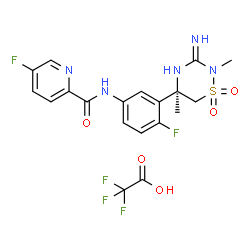2095432-65-6
| Name | 5-Fluoro-N-{4-fluoro-3-[(5R)-3-imino-2,5-dimethyl-1,1-dioxido-1,2,4-thiadiazinan-5-yl]phenyl}-2-pyridinecarboxamide trifluoroacetate (1:1) |
|---|---|
| Synonyms |
Acetic acid, 2,2,2-trifluoro-, compd. with 5-fluoro-N-[4-fluoro-3-[(5R)-tetrahydro-3-imino-2,5-dimethyl-1,1-dioxido-2H-1,2,4-thiadiazin-5-yl]phenyl]-2-pyridinecarboxamide (1:1)
5-Fluoro-N-{4-fluoro-3-[(5R)-3-imino-2,5-dimethyl-1,1-dioxido-1,2,4-thiadiazinan-5-yl]phenyl}-2-pyridinecarboxamide trifluoroacetate (1:1) MFCD28963974 |
| Description | Verubecestat (MK-8931) TFA is an orally active, high-affinity BACE1 and BACE2 inhibitor with Ki values of 2.2 nM and 0.38 nM. Verubecestat TFA effectively reduces Aβ40 and has the potential for Alzheimer's Disease[1][2]. |
|---|---|
| Related Catalog | |
| Target |
Ki: 2.2 nM (BACE1) and 0.38 nM (BACE2)[1] |
| References |
| Molecular Formula | C19H18F5N5O5S |
|---|---|
| Molecular Weight | 523.43 |
| Exact Mass | 523.094910 |
